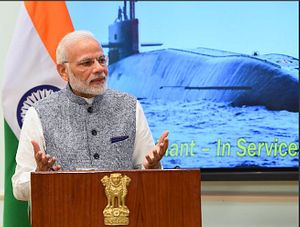For the second time in six days, India conducted a test-launch of its longest-range submarine-launched ballistic missile, the K-4, from an underwater pontoon. The test was the second this month, with another taking place on January 19.
Like the first test, the second K-4 launch was reported to have been successful. “The K-4 is now virtually ready for its serial production to kick-off. The two tests have demonstrated its capability to emerge straight from underwater and undertake its parabolic trajectory,” said an official source cited by the Times of India.
The test took place in the Bay of Bengal, off the coast of the Indian state of Andhra Pradesh, near Vizag, and was overseen by the Defense Research and Development Organization (DRDO), the Indian government’s agency for the development of indigenous weapons systems.
A nuclear-capable missile, the K-4 will eventually arm India’s fleet of nuclear-propelled ballistic missile submarines. Currently, a single Indian ballistic missile submarine, INS Arihant, is operational. The K-4 is reported to have a range capability of around 3,500 kilometers.
Aside from the K-4, India has also developed the K-15 Sagarika short-range submarine-launched ballistic missile. Also nuclear-capable, the Sagarika has an estimated range capability of 700 kilometers. The Sagarika is primarily positioned to hold targets in southern Pakistan, including Karachi, at risk from the Sea.
As I explained last week, India is not the only Asian nuclear power investing in its undersea nuclear deterrent:
Alongside India, both China and Pakistan are investing in sea-based nuclear forces. China is currently on its second generation of ballistic missile submarines, which are equipped with the JL-2 submarine-launched ballistic missile. Beijing is developing the JL-3, a longer-range submarine-launched ballistic missile.
Pakistan, meanwhile, has been developing the Babur-3 submarine-launched cruise missile, which will eventually arm its three Agosta 90B attack submarines. The Babur-3, when deployed, will be Pakistan’s first sea-based nuclear capability.
INS Arihant completed its first deterrent patrol in 2018. In November 2018, Indian Prime Minister Narendra Modi made a national announcement confirming the ballistic missile submarine’s completion of a first deterrent patrol.
India has launched and is developing a second ballistic missile submarine, INS Arighat, which may see commissioning into the Indian Navy later this year. The Indian Navy envisages a ballistic missile force comprising four vessels eventually. Follow-on vessels in the Arihant class—codenamed the S4 and S4*—are under development as well.
Most of India’s nuclear forces are land-based. India is a triad power, with a sea-, land-, and air-based nuclear delivery capability.

































